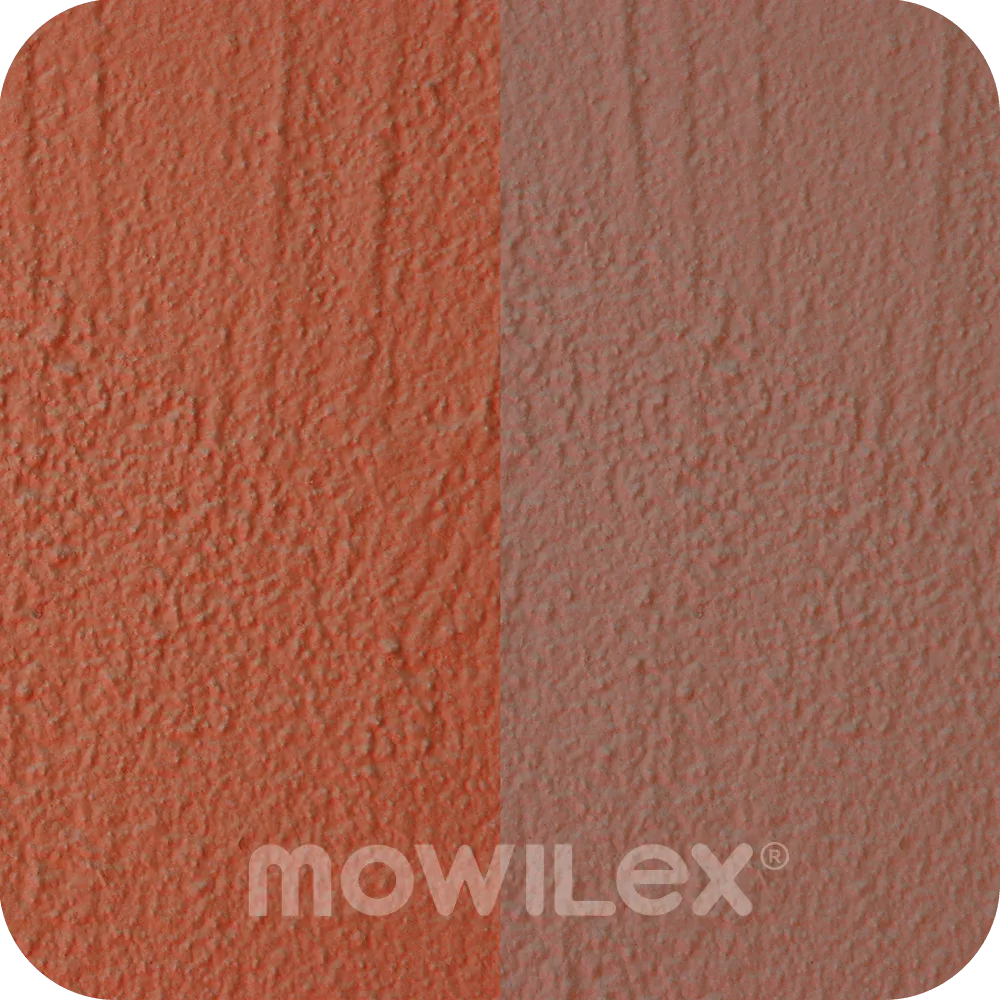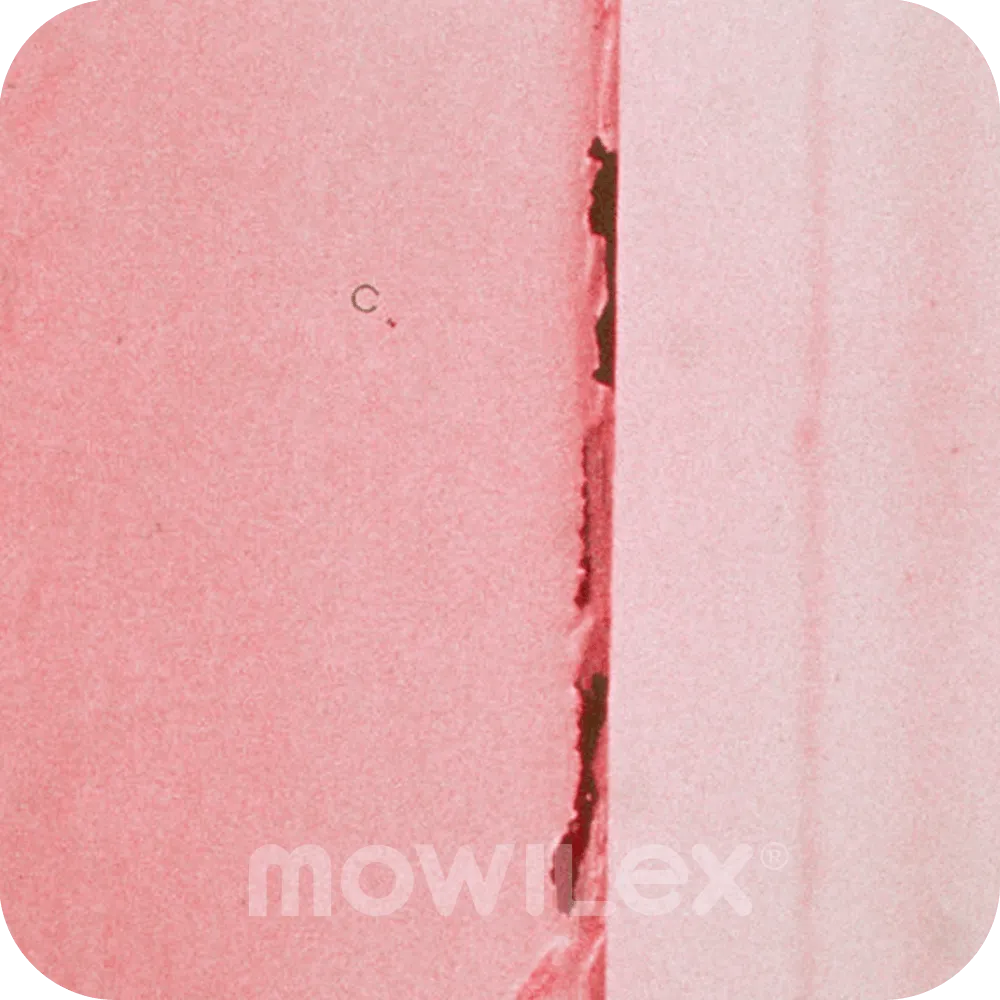Definition:
• Fading color or poor color retention occurs when the colors of a paint coating fades in a short amount of time and fades evenly across a wide area. Usually this occurs on surfaces that directly face incoming sunlight.
• Fading colors can also be cause by calcification on paint layers (see Paint Chalking) or efflorescence (see Efflorescence).
Causes:
• Use of low quality paint or using interior paints in exterior (outdoor) areas.
• Use of paints with UV ray sensitive colors such as light red, yellow, and certain shades of blue.
Solutions:
• If the fading colors of the paint coating are caused by paint chalking or efflorescence, apply the steps as recommended under the relevant issues.
• If a low quality, UV ray sensitive paint was used, then repaint using exterior paints such as Mowilex Weathercoat or Mowilex Waterproof WP02 with the recommended colors for outdoor areas.
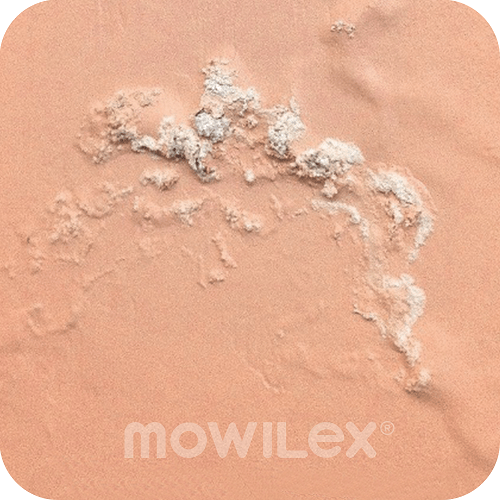
Definition:
• Efflorescence is when salt grains appear on the surface of a painted wall. This can either be a thin layer of salt or a thick salt deposit that appears on the surface of a coating of wall paint. This salt layers appears on the surface of the paint layer carried by water until it evaporates and leaves behind a white colored salt deposits.
• Efflorescence frequently occurs in Indonesia due to soils containing salts and also because a majority of Indonesia is surrounded by sea. Usually, buildings in coastal areas around Indonesia are more vulnerable to efflorescence.
Causes:
• Wall paint was applied when the skim coat hasn’t dried. This is when the skim coat has a dampness of over 18% and the pH is over 9.0.
• Use of low quality base paint or not using base paint at all.
• High level of humidity from the surrounding environment which can penetrate into the wall surface.
Solutions:
• Clean off salt and dirt sticking to the wall such as dust, sand, and paint residue with a putty knife, a wire brush, and sandpaper. Then rinse with clean water. Wait until dry or use a drying cloth to speed up the drying process.
• Use a good quality alkaline resistant primer base paint such as Mowilex Undercoat Cat Tembok. For areas with high levels of humidity and especially around coastal areas, it is recommended to use a good quality base paint such as Mowilex WP Wall Sealer DR-31.
• Next, a topcoat paint coating can be applied such as Mowilex Interior atau Exterior paints.
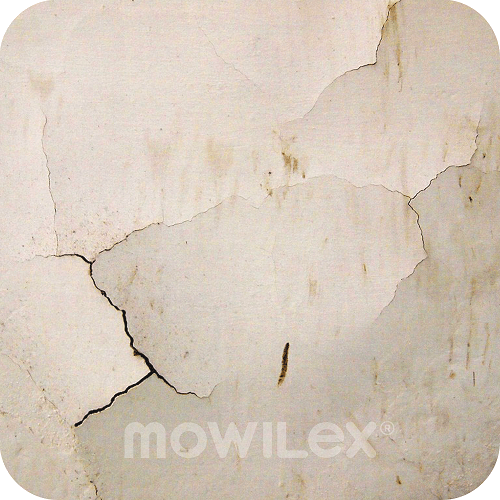
Definition:
• Hairline cracking is defined by fine cracks on a painted surface. Usually they are visible on the surface, other times they may not be. Sometimes this causes the paint layer to peel off.
Causes:
• Too much thinner is used or application of paint is too thin.
• Inadequate preparation of the surface, especially if the paint is to be applied on wood without a base paint.
• Painting was done in cold weather conditions or during strong winds which can cause paints to dry too quickly.
• Application of paint was done on a surface which has been frequently painted over causing the base paint to lose flexibility and unable to expand and shrink with the surface to respond to changes in temperature and on the surface.
• Skim coat suffers from hairline cracks.
Solutions:
• Determine if the cracks are caused by peeling paint.
• If there are parts that are peeling, then:
– Scrape any peeling paint by using a putty knife or wire brush, and if needed also use paint remover.
– Sand until fine, and then clean leftover sand dust with a wet cloth.
– After the paint has been scraped off until the base surface and there are large, visible cracks, use Mowilex Alcaplast AP 100 Skim Coat Grey and Alcabond to cover up the cracks.
– When dry, sand and clean any leftover sand dust with a wet cloth.
– Repaint with using Mowilex Undercoat Cat Tembok base coat.
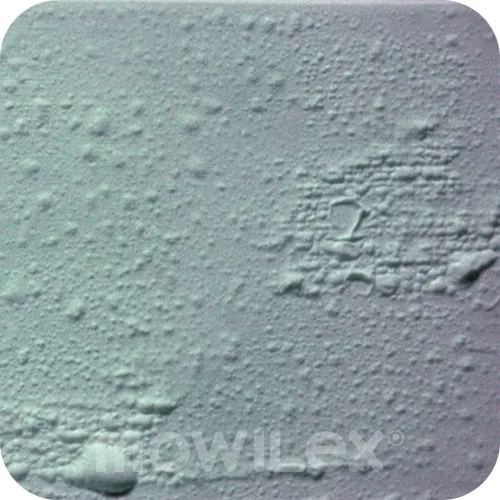
Definition:
Paint chalking is when there is a formation of fine powder usually white (similar to blackboard chalk) on the paint surface caused by weathering on the paint surface.
Causes:
• The surface of the painted wall is exposed to sunlight and damp conditions over a long period of time.
• Use of low quality wall paints.
• Paint applied is thinner than it should be.
• Base paint not used or low quality base paint was applied to surface.
Solutions:
• Clean the calcified surface by scraping, sanding, or scrubbing. Make sure that the entire calcified surface has been peeled off and then clean off.
• Use water to wash out any loose calcification. If there is any residual oil, use detergent.
• Wait until dry or use a drying cloth to speed up the drying process.
• If the calcified area is small and the previous paint coating is still in good condition, then after cleaning there is no need to apply a base paint.
• If the surface is only slightly calcified and the existing paint coating or primer is still intact, after cleaning, use Mowilex Wall Sealer WB or Mowilex Wall Sealer SB.
• If there is heavy calcification in the concerned area and it is peeled to the skim coating, then use Mowilex Undercoat Cat Tembok first before applying Interior or Exterior wall paint.
Definition:
Paint burnishing is when there is an unwanted incrase in gloss or sheen to a layer of paint when it is rubbed or scrubbed. Usually, this problem is more apparent in dark colors.
Causes:
• Using non sheen (matt) paints in a high friction area.
• Frequent washing and cleaning on the painted area, especially with materials such as cloths and sponges.
• Using low quality paints with inadequate resistance to stains and scratches.
Solutions:
• Use a high quality paint such as Mowilex Vinyl Silk atau Mowilex Acrylic Gloss Enamel in a high traffic area where there is frequent friction with the paint surface.
• Consider using paints with gloss or a higher sheen than the concerned area.
• When cleaning out stains, clean the painted surface with a soft cloth or sponge and cleaning agent (do not use sandpaper), and then clean off with water.
Definition:
Paint blocking is when layer of paint sticks to another paint layer from another surface. This usually happens when a layer of paint hasn’t completely dried, for example a layer of paint on a door sticks to another paint layer on a wall. When a layer of paint sticks to another, usually that layer will peel off and stick to another surface.
Causes:
• Using slow drying paint or oil based paint that has been stored for too long.
• Application of paint layer before the previous layer has completely dried.
• Too much paint applied to surface.
• Using low quality paints not made to prevent paint blocking.
Solutions:
• If paint layers are stuck to one another, sand the surface to get rid of stuck paint layers.
• Clean off dust and dirt, and then apply Mowilex Undercoat Tembok to the surface.
• Use Interior or Exterior paints with anti blocking (non stick) properties.
• To prevent repeated paint blocking, use quality primers.
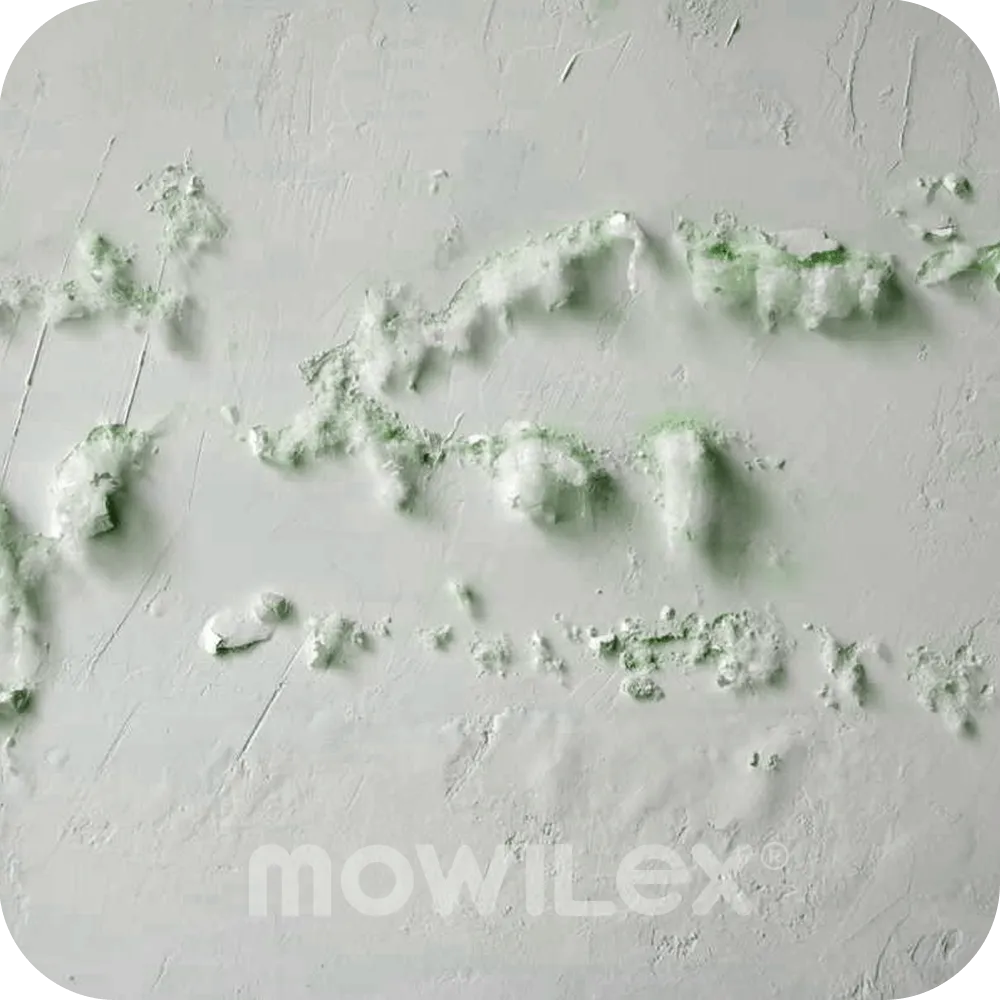
Definition:
Paint blistering is when a layer of is lifted from the substrate layer so it appears to be bubbling. It is usually caused by dirt under the paint layer, hot weather conditions, a damp environment, or a combination of these. These conditions will eventually cause the paint layer to peel off.
Causes:
• Application of wall paint when the surface condition is too hot or wet due to moisture, extreme humidity, or during rain.
• The applied surface is directly adjacent to a damp wall such as bathroom, kitchen, or laundry room walls.
• The surface of the wall was not well prepared, for example, it was not thoroughly cleaned.
• Mistake in painting system, for example, alkyd paints applied on top of (water based) emulsion paints.
Solutions:
• If the bubbling or peeling paint is not wet, scrape off the paint and then sand the wall until it is cleaned.
• Then, apply Mowilex Wall Sealer WB before applying the appropriate Interior or Exterior wall paint.
• If the bubbling paint is wet, scrape off all the bubbling paint untuk the substrate surface.
• Then, apply Mowilex Water Proofing Wall Sealer before applying the appropriate Interior or Exterior wall paint.
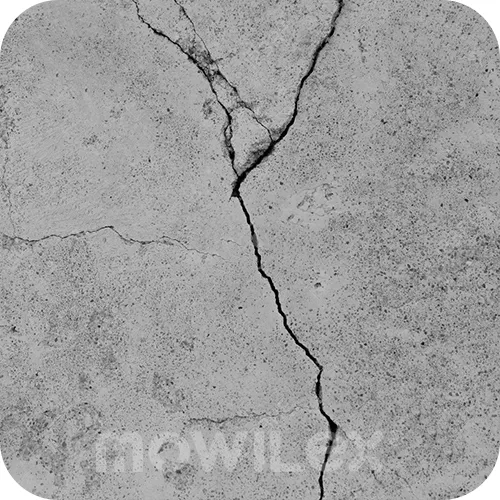
Definition:
Large cracks are defined as cracks on the surface of skim coat with a width of 0.5 to 3 mm, usually lengthwise in shape.
Causes:
• Movement in the building structure.
• Imperfect plaster connections.
• Conduit or cable pipelines were not completely repaired.
Solutions:
• Use Mowilex Alcaplast Repair AP 800 skim coat as recommended by manufacturer.
• Avoid applying skim coat under direct sunlight; use a roof protector to protect areas that will be fixed.
• Add Mowilex Alcabond bonding agent to increase adhesiveness.
• To clean cracked areas, widen the crack until it’s slightly wider using a chisel or grinder.
• Apply Alcaplast Repair AP 800 skim coat to the cracks with a width of 1 to 2 mm until the cracklines are smoothed out.
• If needed, smooth out the cracks with unaffected areas, Alcaplast Repair AP 800 and Alcabond can also be used to create thin skim coat.
• When dry, sand and clean off any leftover dust using a wet cloth.
• After the layer of Alcaplast Repair AP 800has dried (after 7 days), apply a coating of Mowilex Undercoat Tembok before applying the paint topcoat.
Definition:
Foaming is the formation of bubbles that create small holes in the shape of craters, that happen when air pockets burst in the paint coating, either during application of paint coating or after the paint coating has dried.
Causes:
• Paint inside the container was shaken.
• Using low quality paints.
• Applied paint dried too soon.
• Using the wrong type of roller.
• Application of gloss or semi-gloss paint on porous surface.
Solutions:
• Sand the affected area and clean off before reapplying paint coating.
• Apply appropriate base paint before applying paint to a porous surface.
• Use Mowilex Interior or Exterior paints.
• Use a paint roller with few cavities.
